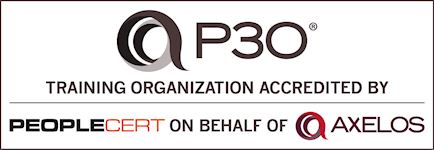- Exam(s) / assessment(s) is included in price
- Tutor is available to students
Portfolio, Programme and Project Offices (P3O)® Foundation and Practitioner - Exam Included
Zenospace International Ltd
Summary
Location & dates
Station Road
CAMBRIDGE
Cambridgeshire
CB224NL
United Kingdom
Great Russell Street
Central London
London
WC1B3LB
United Kingdom
St Nicholas Circle
LEICESTER
Leicestershire
LE15LX
United Kingdom
West Street
NORTHAMPTON
Northamptonshire
NN37RR
United Kingdom
Overview
Our five-day intensive P3O® course provides you with the knowledge and understanding of the P3O guidance enabling you to interact effectively with, or as a member of, an office within a P3O® model.
The P3O® Foundation and Practitioner course will enable you to gain an in-depth understanding of the P3O® model and the elements, roles, functions and tools and techniques deployed in a P3O® model embedding you with a decision enabling/delivery support structure for all change within an organisation.
The Portfolio, Programme and Project Office (P3O®) builds on references in Prince2®, Managing Successful Programmes (MSP®), and Management of Risk (M_o_R®) and Management of Portfolios (MoP®) to provide a single information source for organisations or individuals wishing to set up or maintain an effective delivery support office.
Certification
Portfolio, Programme and Project Offices (P3O) Practitioner
Course media
Description
What you’ll learn:
Area 1: P3O® Overview
- Definition of P3O®
- P3O® Model Elements
- Objectives and Differences between Portfolios, Programmes and Projects
- Portfolio, Programme and Project Management (PPM)
- Business As Usual (BAU)
- Relationship between PPM and BAU
- Decision-making and Delivery Support Model
- Governance Responsibilities of P3O®.
Area 2: Why Have a P3O®?
- Elements of Business Change Governance
- Justification for Implementing P3O®
- P3O® Value Matrix
- P3M3 Assessments
- P3O® Vision, Blueprint, Business Case and Benefits Map
- Key Performance Indicators (KPIs) to measure Success
- Common Barriers to P3O® Implementation
- Maximising the Value of P3O®
- Types of Funding Models and Cost Models
- Typical Timescales for Implementing P3O®
- Delivering Change and Adding Value to an Organisation.
Area 3: Models and Tailoring
- 3 Different Functional Areas and Different Types of Offices
- Different Strategic Planning or Portfolio Support Functions
- Different Delivery Support Functions
- Different Centre of Excellence (CoE) Functions or Services
- Typical Factors affecting P3O® Model Design
- Centralized and Decentralized Offices
- Characteristics and Success Factors for a P3O® Model with Different Offices and Models
- Key Considerations of Distributed Models
- Integration of a P3O® Model with a Wider Organisational Model
- Independent P3O® Assurance Services
- P3O® Governance Services
- Roles of Information Assurance and P3O® Role
- Typical non-PPM Functions
- Key Drivers and Factors for Sizing a P3O®.
Area 4: Implement and Re-energize
- Key Activities in the Implementation Lifecycle for a Permanent P3O®
- 4 Sections of a Typical P3O® Blueprint
- Implementation Lifecycles for a P3O®
- Key Activities and Outputs of Processes of the Implementation Lifecycles for Different P3O® Types
- P3O® Information Flow
- Key Sources of Threats to Achieve the Blueprint
- PPM Maturity
- Implementing and Re-energising a P3O® in a given scenario.
Area 5: How to Operate a P3O®
- Tools and Techniques for P3O®
- Benefits of using standard Tools and Techniques
- Critical Success Factors to ensure Successful Implementation of Tools and Techniques
- Portfolio Prioritization and Optimization
- Complexity Modelling
- Management Dashboards and Knowledge Management
- P3O® Information Portal
- Facilitation – Workshop Techniques.
Area 6: Roles
- P3O® Management, Generic and Functional Roles
- Skills and Competencies needed for P3O® Staff
- Key Responsibilities of P3O® Management Roles
- Key Responsibilities of P3O® Generic Roles
- Key Responsibilities of P3O® Functional Roles
- P3O® Resources and Team Structure of P3O® Roles.
Who is this course for?
This course is designed for professionals working within a P3O® model or, anyone wishing to understand the terminology and concepts underpinning P3O®.
The P3O® certification is for candidates:
- Who need to understand the terminology and concepts underpinning P3O®
- Who are members of offices within a P3O® model
- Who wish to pursue higher level qualifications in P3O®
- Those wanting to understand the terminology and concepts underpinning P3O®.
- Professionals wishing to take an active role within any office in the P3O model
- Professionals currently working within a management role
- Professionals in generic or functional roles wishing to gain an in-depth understanding of the P3O® model; and
- Those who see the P3O® model as a framework for a career path in Project Management.
Requirements
Most importantly, participants should have a desire to work in a P3O® model environment.
Delegates must have passed the P3O® Foundation exam prior to taking the P3O® Practitioner exam.
Please contact us if you have any questions regarding the requirements of this course.
Career path
Build your career in senior management with the P3O® Certification.
Questions and answers
Reviews
Currently there are no reviews for this course. Be the first to leave a review.
Legal information
This course is advertised on reed.co.uk by the Course Provider, whose terms and conditions apply. Purchases are made directly from the Course Provider, and as such, content and materials are supplied by the Course Provider directly. Reed is acting as agent and not reseller in relation to this course. Reed's only responsibility is to facilitate your payment for the course. It is your responsibility to review and agree to the Course Provider's terms and conditions and satisfy yourself as to the suitability of the course you intend to purchase. Reed will not have any responsibility for the content of the course and/or associated materials.
.png)


